About Terrines.
The terrine is a baked forcemeat, often but not always containing one or more types of garnish. Terrine is baked in an earthenware dish. The dish itself is also called a terrine, a word derived from the French Terre, meaning "earth". Today, other materials besides earthenware, such as glass or metal, may be used for terrines. Terrines may be presented in their baking dish, or they may be unmolded.
The preparation of the Terrine
Terrines may be baked in molds of various shapes and sizes. Traditional oval molds, for example, have long been popular. For ease of portion control, however, rectangular molds are the most appropriate.
A terrine may be lined with thin sheets of fatback, although this is optional. The layer of fat does not contribute significantly, as is widely believed, to keeping the meat moist during baking; After all, the terrine mold itself is more moisture proof than the layer of fat. Although such a fat lining is traditional, today's diners are more likely to find a rim of fat unappetizing. Of course, the fat layer can be removed before serving. Alternatively, a sheet of caul fat, which is much thinner than a sheet of fatback, can be used to line the mold.
Modern terrine -- Aspic mold.
The discussion above is talking about the traditional cooked terrines-- that is, the raw forcemeat is cooked in the mold. There are many kinds of uncooked terrines as well. These are not cooked after assembly but are chilled until set. Any ingredients that require cooking are cooked before assembly.
Aspic based terrines are simply glorified gelatin molds, that is they consist of solid ingredients held together by gelatin in the form of aspic jelly. The proportion of aspic to solids can vary greatly. At one extreme, there may be just enough aspic to hold the solid ingredients together, so that the aspic jelly itself is almost not evident. On the other hand, the aspic may predominate, with solid ingredients suspended in it at intervals. For this latter type to succeed, the aspic jelly must be with good flavor, not too firm in texture and with sparkling clarity.
About the recipe.
This recipe is an easy homemade style, need not bake and easy tools are required. the method of making the terrine in this recipe is by consomme and gelatin which will form a dish for the terrine itself, chill to set.
Scallop and vegetables terrine
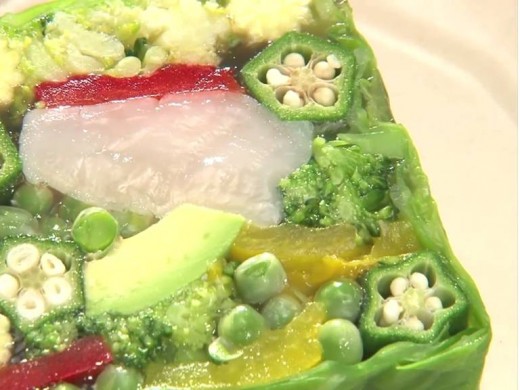
Source
Cook Time
Prep time: 30 min
Cook time: 3 hours
Ready in: 3 hours 30 min
Yields: 6 pax
Ingredients
- 4 nos Sashimi grade fresh Scallops
, blanched
- 1 cup Water, for the scallop blanching
- 1/2 cup White Wine
, for the scallop blanching
- 1 sprig Dill, for the scallop blanching
- one pinch Salt, for the scallop blanching
- 3 pieces Big cabbage leaves
- 4 stick Lady's fingers
- 1/4 nos (big) Red paprika
- 1/4 nos (big) Yellow paprika
- 1/3 nos Broccoli
- 1/4 nos Avocado
- 6 stick Young corn
- 4 tablespoons Frozen green pea
- 7 grams Gelatin
block, For the Aspic Jelly (Gelee)
- 200 ml Consomme
, For the Aspic Jelly (Gelee)
- 2 pinches Salt, For the Aspic Jelly (Gelee)
- 1 tbsp (need adjustment) (A) Lemon
, For the dill mayonnaise
- 1 whole lemon (A) Lemon Zest, For the dill mayonnaise
- 100 grams (A) Mayonnaise
, For the dill mayonnaise
- 1/2 teaspoon (A) Salt, For the dill mayonnaise
- one pinch (A) Black pepper, For the dill mayonnaise
Ingredients
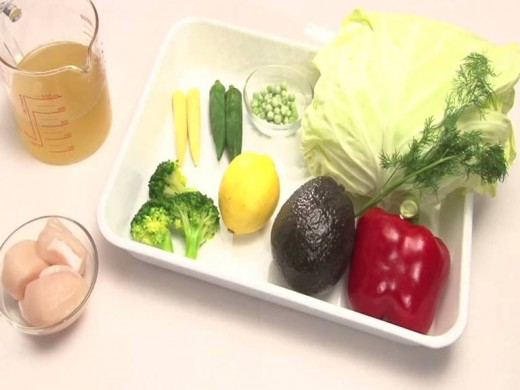
Source
Let's chill
- Mise en place: Blanch the cabbage, lady finger, paprika(bell pepper), broccoli, young corn, with salt water.
- Mise en place: Halve the big cabbage leaves and remove the stem. Quarter the paprika and peel the skin if possible. Cut the broccoli into bite size. Steam the whole Avocado in a microwave oven for 15 seconds, thick slice. Soften the gelatin block in water. Separate the dill leaves from the dill stem, chopped the dill leaves finely. Standby a terrine pan, 9cm x 14cm x 7cm (width x length x height).
- ) Blanch the Scallop (sashimi grade could eat even it is raw) : Add the water, white wine, salt, and dill stem into a saucepan, then bring to a boil and seize fire. add in the fresh scallop, remove the scallop from the hot liquid once its outer layer is turning white.
- Make the Jelly with another saucepan: Add in the consomme, and a pinch of salt, then bring to a boil. Seize the fire once the liquid is boiling, add the soften gelatin block and stir gently to dilute it into the consomme. Set aside to cool.
- Arrange the terrine: Wet the terrine pan with a little of water, then spread a layer of cling film on it. spread the cabbage leaves to cover the bottom, then arrange as you like, young corn, lady finger, thick slices Avocado, broccoli, green peas, paprika. Balance the color and stuff the terrine pan tightly.
- Pour the gelatin liquid: Lift the terrine pan into an insert or whatever to prevent the overflow of liquid, stream the gelatin liquid into the block of vegetable, then cover the block with the excessive of the big cabbage leaves and pour the remaining gelatin liquid on it.
- cover the block of terrine with the wrap and press gently to remove the air inside and pressing the jelly through every part of the block terrine.
- put something heavy on the terrine to apply pressure and chill it in the fridge for 3 hours.
- Remove the terrine from the pan and remove the plastic wrap, then wrap it with a layer of aluminum foil before the slicing, this will help you to get a nice slice.
- For the dressing: Mix well the group (A) ingredients and the chopped dill leaves to make the dill mayonnaise.
Instruction with picture
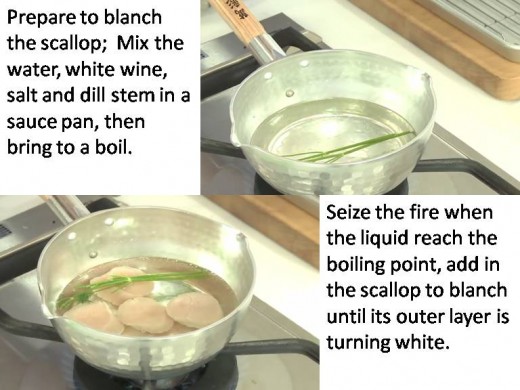
Prepare to blanch the scallop | Source
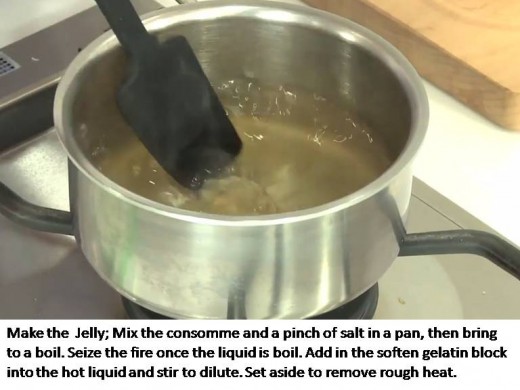
Prepare the Aspic Jelly.
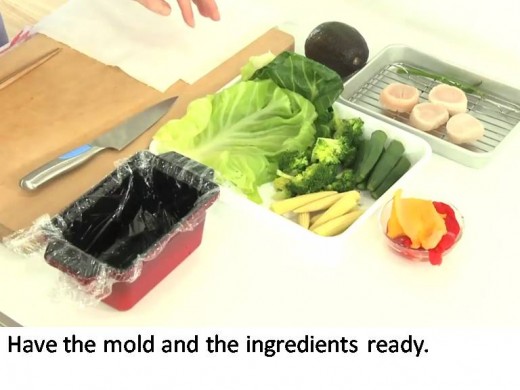
Ready the ingredients and the mold.
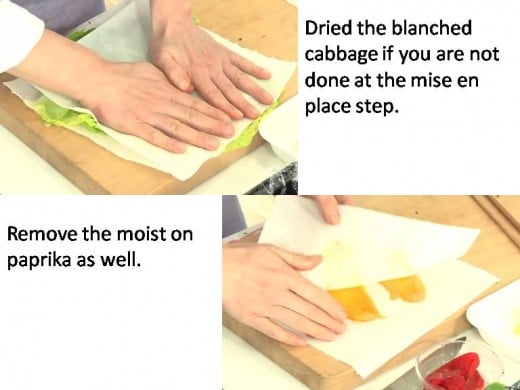
Dry the blanched vegetable.
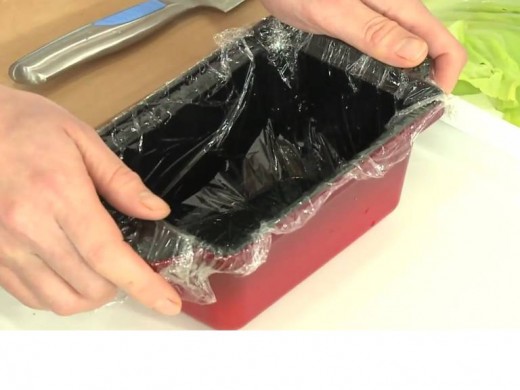
Wrap the mold.
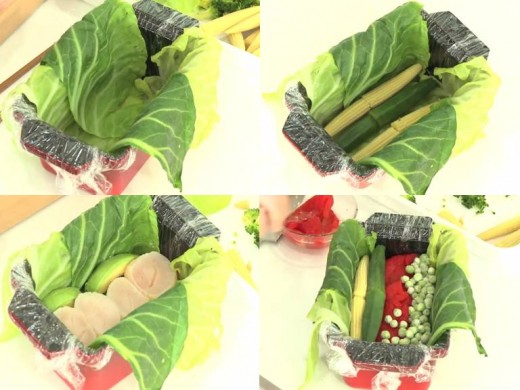
Arrange as your like it.
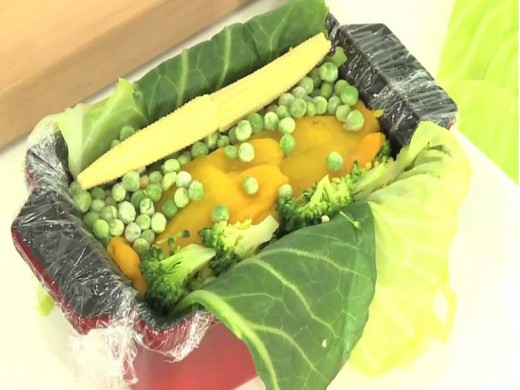
A sample of the arrangement.
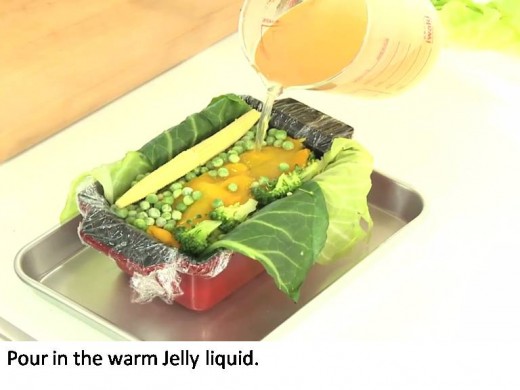
Pour in the Jelly liquid in a stream.
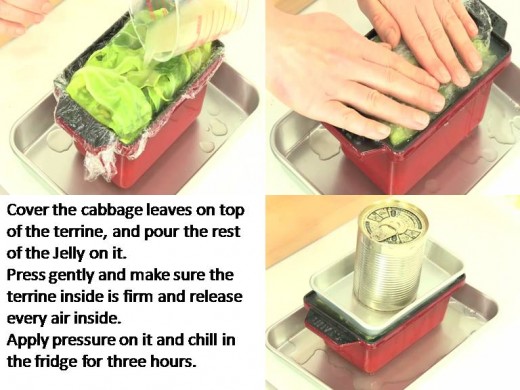
Press gently to squeeze the air, apply pressure and chill for three hours.
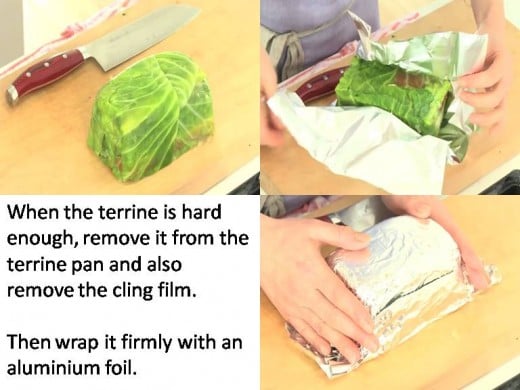
Remove from the pan and remove the cling film, then wrap with aluminum foil.
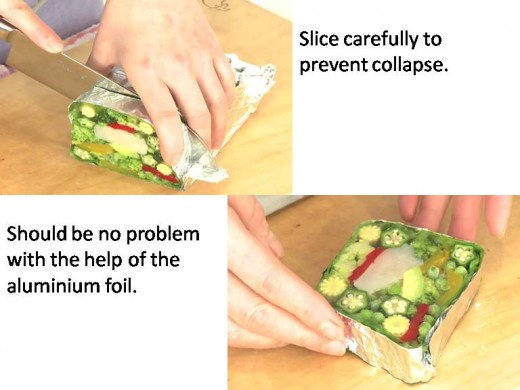
Slice the terrine.
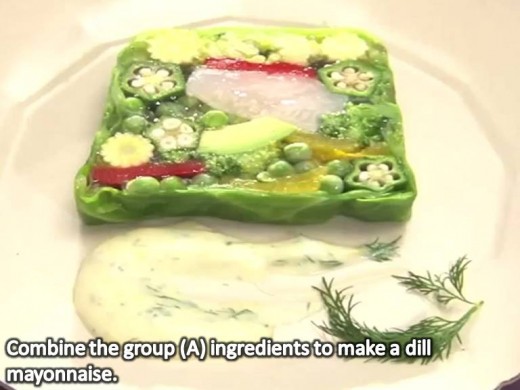
Mix the group (A) ingredients to make the dill mayonnaise.

No comments:
Post a Comment